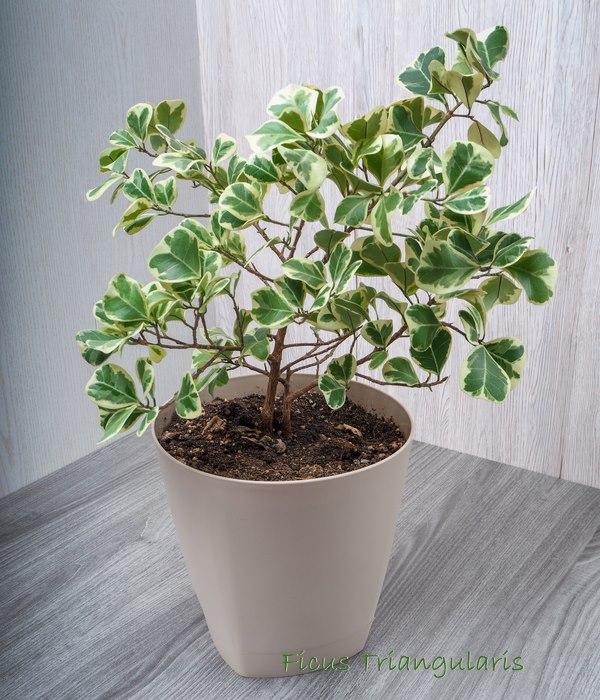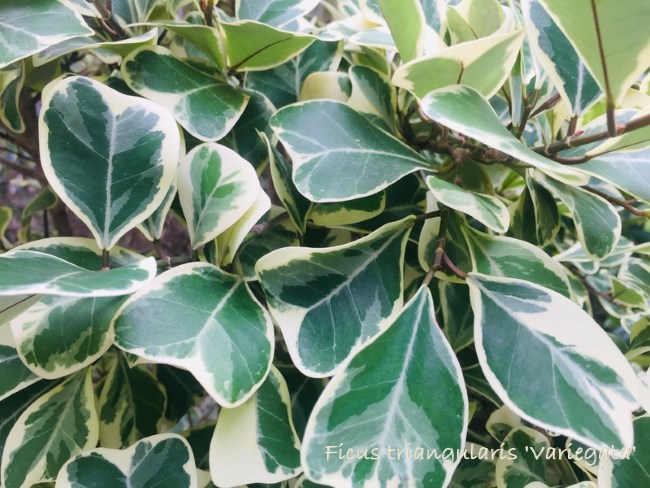May 18, Ficus Triangularis ‘Variegata’ is Gorgeous and Easy-to-Grow Indoors
Variegated Ficus triangularis delivers dramatic leaf patterns, making this handsome houseplant showy enough to display on its own. Set a young plant on a table, then as it matures, let it shine as a floor plant.
It’s also easy to grow, giving us a new favorite from the fig family. It’s ideal for beginners.
 Captivating style and low-maintenance — this shrub has it all. Photo © Elvira Kolomiytseva
Captivating style and low-maintenance — this shrub has it all. Photo © Elvira KolomiytsevaGet to Know Triangleleaf Fig
Shrubby Ficus triangularis offers a riot of color, texture, and form all in one. Naturally compact, it makes an excellent indoor plant.
Slow-growing, it will eventually reach several feet tall, but you can prune it as much as you want to control its size. Spring is the best time to prune, when your plant is beginning its most vigorous time of growth.
This highly ornamental shrub is generously covered with foliage, distinctly triangular-shaped with rounded edges. ‘Variegata’ is a sought-after cultivar for its stunning variegated green leaves with creamy white edges.
Does it grow figs indoors? Yes, this is one of the few Ficus species that produces fruit indoors, although the figs are tiny and not edible.
Ficus Problems, Solutions and Answers
Wondering when to repot? Move your plant up one size (1 to 2 inches) when its roots are coiled in the pot or growing out the drainage holes. Use a heavy container for larger plants to help balance its weight. Tall plants are top-heavy. Repot in spring. Find out how to repot houseplants here.
Something bugging your plant? Watch for scale insects and mealybugs that may infest Ficus plants. Look along the stems and undersides of leaves, where they like to hide. Isolate an infested plant and treat it right away with insecticidal soap.
Yellow, drooping leaves are a symptom of over-watering. One thing this plant won’t tolerate is soggy potting mix. Use a pot with drainage holes and empty drainage tray after watering. See “Water” tips below.
Dropped leaves are likely a result of low light levels or a sudden change in light. Ficus triangularis isn’t as temperamental as its family member, the weeping fig, but it doesn’t like change in light, temperature or …well, any change. Take care not to over-water a Ficus that’s dropping leaves because that may make the problem worse. Raising the humidity around it may help.
Are Ficus plants poisonous? Yes, the sap is toxic to pets if eaten. It can cause skin and eye irritation for people who come in contact with the sap. As a precaution, it’s a good idea to wear gloves when pruning or repotting this plant.
 Bordered with white, the green pattern is heart-shaped. Photo © Wipavadee Boonyatha
Bordered with white, the green pattern is heart-shaped. Photo © Wipavadee BoonyathaFicus Triangularis Care
Origin: Southeast Asia
Height: 4 to 6 ft (1.2 to 1.8 m)
Light: Bright, indirect light year-round. Plants that don’t grow much, are dropping leaves, or lose their variegation, probably aren’t getting enough light.
Water: Water thoroughly, then allow to dry out slightly between waterings. Ficus will not tolerate soggy soil. Keep soil slightly drier in winter, when light levels are lower and growth is slower. Yellow leaves are a symptom of overwatering.
Humidity: Relative humidity levels up to 70% are best for Ficus triangularis. It’s a good idea to use a humidity gauge near your plant, rather than guess, because indoor air can become extremely dry during the winter months without our noticing it. The most efficient way to boost humidity for your houseplant is with a cool-mist room humidifier.
Temperature: Average to warm room temperatures (65-85°F/18-29°C). Ficus triangularis prefers warm temperatures like we do, but will tolerate a minimum of 50°F/10°C. Keep your plant away from cold drafts and heat/AC vents.
Soil: Soilless potting mix
Fertilizer: Feed once a month spring through fall with a balanced water-soluble fertilizer. Or drop time-release fertilizer granules on top of the potting medium before watering. Don’t feed your houseplant in winter when growth is slower.
Propagation: Ficus triangularis roots easily from stem tip cuttings. Spring is the best time to propagate cuttings because this plant is beginning its most vigorous time of growth. Take 3-inch (8 cm) tip cuttings with a few leaves attached and place cuttings in potting medium, kept lightly moist and warm (around 70°F/21°C).
Published at Wed, 18 May 2022 14:19:31 -0700